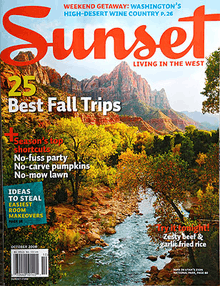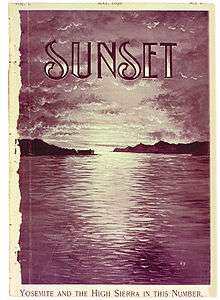Sunset (magazine)
 | |
| Frequency | Monthly |
|---|---|
| Total circulation (2014) | 1,262,587[1] |
| First issue | 1898 |
| Company | Time Inc. |
| Country | United States |
| Based in | Oakland, California |
| Language | English |
| Website |
www |
| ISSN | 0039-5404 |
Sunset is a lifestyle magazine in the United States. Sunset focuses on homes, cooking, gardening, and travel, with a focus almost exclusively on the Western United States. The magazine is published monthly by the Sunset Publishing Corporation, part of Southern Progress Corporation, itself a subsidiary of Time Warner.
History
Establishment

Sunset began in 1898[2] as a promotional magazine for the Southern Pacific Transportation Company, designed to combat the negative "Wild West" stereotypes about California.

The Sunset Limited was the premier train on the Southern Pacific Railroad's Sunset Route, which ran between New Orleans and San Francisco (the train is still in operation--from Los Angeles--as part of the national Amtrak system). Sunset Magazine was started to be available onboard and at the station, in order to promote the West. It aimed to lure tourists onto the company's trains, entice guests to the railroad's resort (the Hotel Del Monte in Monterey), and possibly encourage these tourists to stay and buy land, since the Southern Pacific was the largest single landowner in California and Nevada.
The inaugural issue featured an essay about Yosemite, with photographs by noted geologist Joseph LeConte. There was information about train travel, as well as were social notes from Western resorts, such as this from Pasadena: "The aristocratic residence town of Southern California and rendezvous for the traveling upper ten has enjoyed a remarkably gay season and the hotel accommodations have been sorely taxed." Poetry featuring railroad themes and a later string of short stories in which characters swapped tall tales, always aboard a train, also highlighted travel by rail. Most of these early stories were penned by Paul Shoup, who later abandoned fiction to become president of the Southern Pacific.
Earthquake and recovery

On April 18, 1906, the 1906 San Francisco earthquake destroyed the Sunset offices. The May 1906 edition was a six-page emergency issue, in stark contrast to the 214-page April 1906 edition. The issue opened with a dire communiqué from E. H. Harriman, president of the Southern Pacific: "The earthquake on the morning of April 18th was the most severe that has occurred since San Francisco became a great city". Next came a message from Sunset's publishers: "This is to announce that by reason of the recent destruction by fire of the Sunset Magazine offices on April 18th, this Emergency Edition will be the only issue of the magazine for the month of May.… The priceless stock of drawing, photographs and engravings was burned.… In one day the accumulation and accomplishment of years were swept away".
Soon, however, the magazine was trumpeting its hometown's revival, in articles like "San Francisco's Future" and "How Things Were Righted After the Fire of 1906". In "A San Francisco Pleasure Cure", an early story by Sinclair Lewis published in the magazine, a tired businessman revived himself through a visit to the rebuilt city.
In 1914, the railroad sold the magazine to its employees, and Sunset began to publish original articles, stories and poetry focusing on the West. The format resembled other national general interest magazines of the day such as Collier's and The Saturday Evening Post. Sunset reported on heavy political and economic issues; contributors included Stanford president David Starr Jordan discussing international affairs and future U.S. president Herbert Hoover discussing the League of Nations. Fiction and poetry became more ambitious, featuring authors such as Jack London, Dashiell Hammett, Mary Austin, and evangelist Aimee Semple McPherson.
Sunset cover art in its early years was of high quality, with the early 20th century being the golden age of magazine illustration. Contributors of cover art included Will James, Maynard Dixon, and Cornelia Barns.
The Lane Publishing era
In the 1920s, the magazine became unprofitable, as it grew thinner and its circulation dwindled. In 1929, Lawrence W. Lane, a former advertising executive with Better Homes and Gardens, purchased Sunset, and changed the format to what would become its current Western lifestyle emphasis.[3] The Lane family would own Sunset for the next 62 years.
During the Depression, weighty ruminations on politics and economics were replaced with frivolous articles like March 1935's "Little Toes, What Now?", which began "This is the season when all the little toes are going not to market, but to have a pedicure".
Eventually, a meatier magazine emerged. Sunset began Kitchen Cabinet, a readers' recipes feature still published today (now titled Reader Recipes). Essays on home architecture became more specifically geared to the West, with a series of sumptuously photographed articles championing the Western ranch house. Travel and garden coverage grew similarly focused and specific. In 1932, Sunset became the first magazine in the nation to publish different editions for different parts of its circulation area, allowing it to better tailor gardening advice to its readers.
Sunset eliminated the use of bylines, and articles were increasingly how-tos, giving it a voice of authority and efficiency. It was a successful formula: by 1938 the magazine was again profitable.
Under Lane's leadership, the company also produced a successful series of how-to home improvement and gardening books, which are still produced today.
Sunset at War
Sunset initially treated World War II as if it were a temporary irritation, but it soon mobilized for war. One story featured newly minted aviation cadets at the Santa Ana Army Air Base. Aware that the federal government's victory garden tips did not always fit Western soils and climates, magazine editors planted their own 1-acre (4,000 m2) test plot near UC Berkeley so that they could give their own advice.
In 1943, Sunset devised a new motto: "The Magazine of Western Living".
At the end of World War II, Sunset presented a series featuring innovative plans for homes to be built once the war was won, by architects including Portland's Pietro Belluschi and Los Angeles's Harwell Hamilton Harris.
When Lane took over the magazine, the population of the West was booming. A few years later, the end of World War II brought an explosion of newcomers. Drawing on his experience from the East Coast-serving Better Homes and Gardens, he guessed correctly that these new Westerners would be hungry for information about how to travel, cook, cultivate, and build in their new environment.
Building Sunset headquarters
For its first five decades, Sunset was headquartered in various downtown San Francisco office buildings. In 1951, the headquarters was moved to Menlo Park, California, a suburb located 25 miles (40 km) south of San Francisco. The 9-acre (36,000 m2) parcel was a remnant of a 19th-century estate owned by the Hopkins family. This land was originally a part of a grant to Don Jose Arguello, governor of Spanish California in 1815.[4] Its new headquarters was designed by Cliff May, known for his designs of ranch-style houses, which had been featured in Sunset for two decades. May created a long, low, adobe homestead that surrounded a central courtyard. The central courtyard, or the Sunset Gardens, were designed by famous landscape artist Thomas Church. For a while, Sunset referred to the Menlo Park headquarters as the Laboratory of Western Living. Its test kitchen processes thousands of recipes a year. It tests its gardening advice in its 3,000 sq ft editorial test gardens, which is designed to achieve high performance in tight spaces. Roughly 50% of Sunset's garden photography is taken in this area.[5]
Relocation
In June 2015 Sunset announced it would be moving its headquarters to Jack London Square (Oakland, California). The new offices opened in December 2015,[6] and the magazine's outdoor kitchen and test gardens were relocated to Cornerstone Sonoma, a winery in nearby Sonoma County, California.[7]
The Time Warner era
Lane Publishing sold Sunset Magazine and books to Time Warner in 1990, and the company was renamed Sunset Publishing Corporation. The first issue of the magazine under Time Warner was published in August 1990.[8] In 2001, Time Warner reorganized Sunset to be part of Southern Progress Corporation, best known for its similar home and lifestyle magazine Southern Living (its similarity to Sunset is no coincidence: its founders came out West to see how the Lanes did it in the early 1960s).
In the 1990s, the franchise began to lose touch with its demographic, who viewed the magazine as something of their parents' era. Newer, fresher-looking lifestyle magazines, such as Martha Stewart Living and Real Simple, presented Sunset with competition. When Katie Tamony took over as editor-in-chief in 2001, she collaborated with new creative director Mia Daminato (former creative director for Australian-based Federal Publishing Company's Magazine Group) to create a new, more modern design.
Western Home Awards program
Since 1957, Sunset's Western Home Awards program, cosponsored by the American Institute of Architects, has introduced readers to works by Richard Neutra, Charles Moore, and Frank Gehry, among other notables.
House of Innovation
The "House of Innovation" is an experimental showcase house, opened on September 8, 2006 in Alamo, California. It is a collaboration between Sunset and Popular Science. It is part of the "Idea House" program, originally launched in 1998.[9]
Environmental reporting
Environmental reporting is a Sunset tradition that dates back to the magazine's early years. It has helped shape the debate on natural treasures as far afield as the Mojave Desert and the Tongass National Forest. The West's national parks have been a particular passion. Occasionally it has sounded an environmental alarm, as it did with its pioneering 1969 article demanding a ban on DDT.
Editors of Sunset magazine
There have been 15 editors of Sunset:
- Charles Sedgwick Aiken
- Charles Field
- E. H. Woodham
- Joseph Henry Jackson
- Lou Richardson
- Genevieve Callahan
- William Nichols
- Walter Doty
- Proctor Mellquist
- William Marken
- Rosalie Muller Wright
- Katie Tamony
- Kitty Morgan
- Peggy Northrop
- Irene Edwards
References
- ↑ "eCirc for Consumer Magazines". Audit Bureau of Circulations. December 31, 2014. Retrieved February 21, 2016.
- ↑ "Top 100 U.S. Magazines by Circulation" (PDF). PSA Research Center. Retrieved February 6, 2016.
- ↑ Rogers, Paul, Lundstrom, Mack. "Publisher, philanthropist dies: Former Sunset Magazine Co-Owner Helped Preserve Coast, Open Spaces." San Jose Mercury News (San Jose, CA), August 1, 2007.
- ↑ Welcome to Sunset Gardens. Sunset headquarters in Menlo Park. p. 4.
- ↑ Welcome to Sunset Gardens. Sunset Publishing. p. 3.
- ↑
- ↑ "Sunset Celebration Weekend 2016". Retrieved 2016-07-28.
- ↑ Tomas Jaehn. "Time Warner: Faithful to the Sunset Mission and Readership". Stanford University. Retrieved August 10, 2015.
- ↑ MSNBC article
External links
| Wikimedia Commons has media related to Sunset (magazine). |
- Sunset Magazine
- A history and bibliography of Sunset Magazine published by Stanford University in 1998
- Early editions of Sunset at Google Books